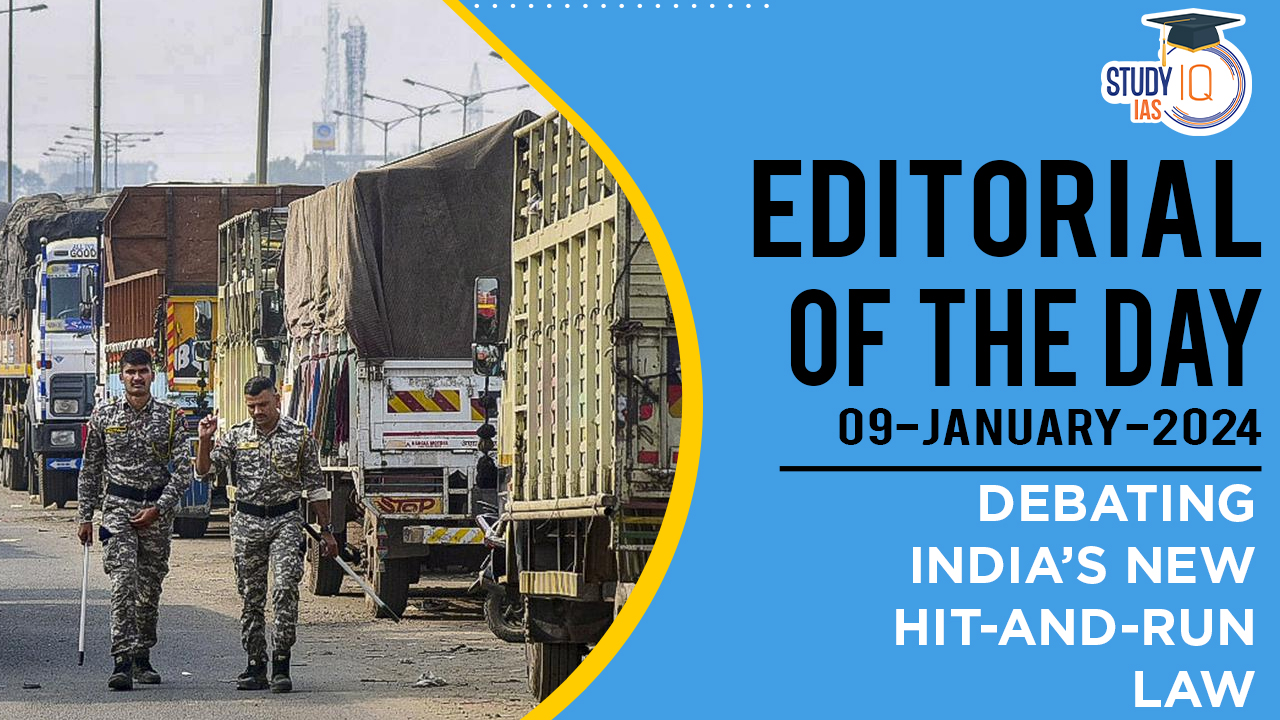Table of Contents
Context: Commercial drivers and transporters from different States are demonstrating against Section 106 (2) of the Bharatiya Nyaya Sanhita, 2023 (BNS), which enforces severe penalties for hit-and-run cases.
About Section 106 (2) of the Bharatiya Nyaya Sanhita, 2023 (BNS)
- Penalties for Hit-and-Run in Section 106(2): Specifies a maximum sentence of 10 years and an unspecified fine for hit-and-run cases, debunking rumours about a fixed Rs. 7 lakh fine.
- Non-Bailable Offence: Classified as a non-bailable section under the Bharatiya Nyaya Sanhita, 2023 (BNS).
- Reporting Requirement for Drivers:
- Drivers who flee to avoid immediate danger but report the incident soon after to the police or a magistrate will be charged under section 106(1) with a maximum penalty of 5 years.
- Failure to report the incident leads to charges under Section 106(2), carrying a harsher maximum punishment of 10 years.
- Comparison with Motor Vehicles (Amendment) Act, 2019: While Section 161 of the 2019 Act provides for compensation to hit-and-run victims, Section 106(2) of the BNS does not impose such a compensation obligation on the drivers.
We’re now on WhatsApp. Click to Join
Alarming Road Crash Statistics in India (2022)
- India recorded its highest road crash fatalities, surpassing 1.68 lakh deaths.
- On average, there were 462 deaths per day, approximately 19 per hour, or nearly one death every 3.5 minutes.
- Despite a global decline of 5% in road fatalities, India experienced a 12% increase in road accidents and a 9.4% rise in fatalities.
- More than half of these fatalities occurred on national and state highways, which constitute less than 5% of India’s total road network.
- India, with just 1% of global vehicles, contributes to around 10% of worldwide crash-related deaths, leading to an economic loss of 5-7% of its GDP annually due to road crashes.
Protestors Concerns And Demands
- Protest Against Harsh Penalties: Transporters are opposing the stringent penalty of 10 years imprisonment and a ₹7 lakh fine for drivers who leave accident scenes without reporting.
- Concerns Over Driver Challenges: The protesters highlight that the punishment doesn’t consider the difficulties faced by drivers, including long hours and challenging road conditions.
- Accidents Due to Uncontrollable Factors: They point out that some accidents are caused by factors beyond a driver’s control, like poor visibility in foggy conditions.
- Fear of Mob Violence: Concerns about mob attacks on drivers who stop to help at accident sites are fueling the protests.
- Perceived Unfair Blame on Drivers: Drivers believe they are often wrongly held responsible for accidents, and the law’s penalties are disproportionate and don’t reflect the realities of road transport.
- Potential Misuse by Law Enforcement: There is apprehension that the law might be exploited by law enforcement to the detriment of drivers.
Principles Underlying The Law
- High Rate of Hit-and-Run Fatalities: In 2022, 47,806 hit-and-run cases were reported by the National Crime Records Bureau, leading to 50,815 deaths.
- Law’s Dual Purpose: Penal laws aim to both deter reckless driving and penalise offenders who flee after causing a fatal accident.
- Mandate to Report Accidents: Offenders are legally required to report incidents to authorities, with failure to do so being criminalised.
- Enforcing Moral Responsibility: The law emphasises a moral obligation towards accident victims, translating this into a legal duty.
- Legal Precedent in Motor Vehicle Accidents: Under the Motor Vehicles Act, 1988, drivers must help injured persons, barring exceptional circumstances.
- The Delhi High Court’s ruling in Rajesh Tyagi vs. Jaibir Singh further underscores the importance of not fleeing accident scenes.
Are the Protests Against Section 106 (2) Justified?
- The belief that Section 106(2) of the BNS mandates a ₹7 lakh fine for not reporting an accident is incorrect; the Act doesn’t specify this amount.
- Section 161 of the 2019 Act provides compensation for hit-and-run victims but doesn’t hold drivers financially responsible.
- Section 106(1) penalises rash or negligent driving with up to five years’ imprisonment if reported, but Section 106(2) increases this to ten years if not reported.
- Despite increased penalties, the offence under Section 106(2) hasn’t been made non-bailable.
Recommendations for Improvement
- Reconciling BNS Clauses: The clauses in the BNS should be reviewed to prevent unfair treatment of over 35 lakh truck drivers in India.
- Equality in Punishment for Different Sectors: The exception for doctors under Section 106(1) suggests a need for fairer treatment across various sectors.
- Revisiting Section 106(2): There’s a need to distinguish between types of driving offences to avoid unjustly penalising drivers and to clarify liabilities.
- Applicability for Serious Incidents: Section 106(2) should apply mainly in cases resulting in death, not minor injuries.
- Alternative Measures for Lesser Offences: For minor injuries, alternatives like community service, licence revocation, or mandatory retests could be more appropriate than criminal penalties.


 Indus Water Treaty 1960 Suspended by Ind...
Indus Water Treaty 1960 Suspended by Ind...
 5 Years of SVAMITVA Scheme and Its Benef...
5 Years of SVAMITVA Scheme and Its Benef...
 Places in News for UPSC 2025 for Prelims...
Places in News for UPSC 2025 for Prelims...





















